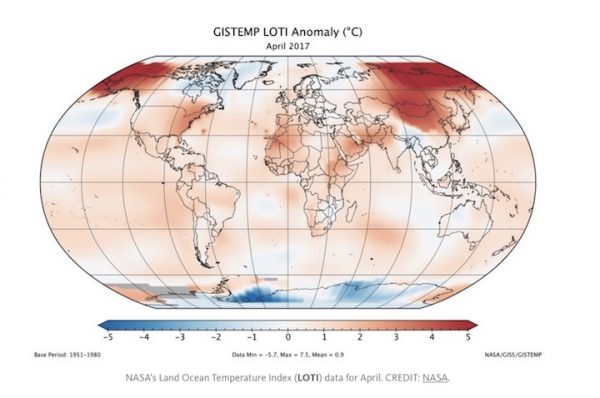“This is ancient carbon, thousands of years old.” It’s being released “much earlier than we thought.”

NASA’s Land Ocean Temperature Index (LOTI) data for April. CREDIT: NASA.
The Alaskan tundra is warming so quickly it has become a net emitter of carbon dioxide ahead of schedule, a new study finds. Note 1.
Since CO2 is the primary heat-trapping greenhouse gas — and since the permafrost contains twice as much carbon as the atmosphere does today — this means a vicious cycle has begun that will speed up global warming. Note 2.
“Because it’s getting warmer, there’s more CO2 coming out which means it’s going to get warmer which means there’s more CO2 coming out,” explained Harvard researcher and lead author Roísín Commane. Note 3. Dr. Commane told ThinkProgress that “warming soils will emit more CO2 and this will overwhelm any CO2 uptake” due to an increase in plantlife from “CO2 fertilization and warmer temperatures.”’
The study is the first to report that a major portion of the Arctic is a net source of heat-trapping emissions. Note 3. As a result, Commane warns that our current climate models need to be updated: “We’re seeing this much earlier than we thought we would see it.”

“We find that Alaska, overall, was a net source of carbon to the atmosphere during 2012–2014,” the study concludes. See Note 1. Data from NOAA’s Barrow Alaska station “indicate that October through December emissions of CO2 from surrounding tundra increased by 73 percent since 1975, supporting the view that rising temperatures have made Arctic ecosystems a net source of CO2.”
The permafrost, or tundra, has been a very large carbon freezer. For a very long time, it has had a very low decomposition rate for the carbon-rich plant matter. But we’ve been leaving the freezer door wide open and are witnessing the permafrost being transformed from a long-term carbon locker to a short-term carbon un-locker.
“This is ancient carbon,” Dr. Commane told Alaska public radio. “The carbon that’s locked in the permafrost in the Arctic is thousands and millions of years old.” Note 5.

Thawing permafrost can release not just CO2, but also methane, a much stronger heat-trapping gas.
While most models that include thawing permafrost look at CO2, Russian scientists have recently discovered some 7,000 underground bubbles of permafrost-related methane in Siberia. Note 6. Since methane traps heat 86 times more effectively than CO2 over a 20-year span, these findings suggest that the effect of the thawing permafrost is even greater than first thought.
Also, a 2008 study, “Accelerated Arctic land warming and permafrost degradation during rapid sea ice loss,” found that rapid sea ice loss — as has been experienced since the study was published — could triple the rate of Arctic warming. Note 7.
Meanwhile, the rapid Arctic warming that is fueling these emissions continues. On Monday, NASA reported that April 2017 was the second-hottest April on record — only April 2016 was hotter. Note 8. As the map above shows, Arctic temperatures were blistering, up to 13.5°F (7.5°C) above the 1951–1980 average.
The longer we delay aggressive climate action, the harder it will be to stuff all the toothpaste back into the tube, and the more catastrophic climate impacts we will face.
This post has been updated for clarity. Dr. Commane reached out to ThinkProgress to make clear that this process would not lead to a runaway greenhouse effect, but would exceed any increase in CO2 uptake from the increase in plant matter expected in the region due to climate change.
Note 1. Roísín Commane et al., “Carbon dioxide sources from Alaska driven by increasing early winter respiration from Arctic tundra,” Proceedings of the National Academy of Sciences of the United states of America (23 May 2017). www.pnas.org/content/114/21/5361
See also: www.people.fas.harvard.edu/~rcommane/publications-/29-pnas-2017-adv_onlinesi.pdf
Note 2. Andrew H. MacDougall, Christopher A. Avis, Andrew J. Weaver, “Significant contribution to climate warming from the permafrost carbon feedback,” nature geoscience (9 September 2012). www.nature.com/ngeo/journal/v5/n10/abs/ngeo1573.html
Note 3. Roísín Commane. www.people.fas.harvard.edu/~rcommane/
Note 4. Chris Mooney, “‘We all knew this was coming’: Alaska’s thawing soils are now pouring carbon dioxide into the air,” The Washington Post (8 May 2017).
www.washingtonpost.com/news/energy-environment/wp/2017/05/08/alaskas-tundra-is-filling-the-atmosphere-with-carbon-dioxide-worsening-climate-change/?utm_term=.c649cb2d78de
Note 5. Elizabeth Jenkins, “Runaway melt: Alaska permafrost is thawing even in winter,” KTOO Public Media (8 May 2017).www.ktoo.org/2017/05/08/runaway-melt-alaska-permafrost-thawing-even-winter/
Note 6. “7,000 underground gas bubbles poised to ‘explode’ in Arctic,” The Siberian Times (20 March 2017). siberiantimes.com/science/casestudy/news/n0905-7000-underground-gas-bubbles-poised-to-explode-in-arctic/
Note 7. David M. Lawrence, Andrew G. Slater, Robert A. Tomas, Marika M. Holland, and Clara Deser, “Accelerated Arctic land warming and permafrost degradation during rapid sea ice loss,” Geophysical Research Letters (13 June 2008). www.colorado.edu/geography/class_homepages/geog_4271_f10/readings/week_10_lawrence_et_al_2008.pdf
Note 8. GISTEMP, “April 2017 Was Second Warmest April on Record,” NASA (15 May 2017).
data.giss.nasa.gov/gistemp/news/20170515/
This article by Joe Romm was first published in ThinkProgress (16 May 2017). thinkprogress.org/alaskas-vicious-cycle-warming-tundra-spews-co2-speeding-up-warming-8cf7aec95fc7

Joseph Romm, Ph.D., is one of the country’s most influential communicators on climate science and solutions. Romm is Chief Science Advisor for “Years of Living Dangerously,” which won the 2014 Emmy Award for Outstanding Nonfiction Series. He is the founding editor of Climate Progress, which New York Times columnist Tom Friedman called “the indispensable blog.” In 2009, Time named him one of its “Heroes of the Environment,” calling him “The Web’s most influential climate-change blogger.” In 2009, Rolling Stone put Romm on its list of 100 “people who are reinventing America.” Romm was acting assistant secretary of energy in 1997, where he oversaw $1 billion in low-carbon technology development and deployment. He is a Senior Fellow at American Progress and holds a Ph.D. in physics from MIT.
Dr. Romm is also author of Climate Change: What Everyone Needs to Know (Oxford University Press, 2015).
“Climate Change, What Everyone Needs to Know is a must-read for those who want to become climate literate and join the growing conversation about the greatest threat humanity faces today.” –The Guardian


No comments yet, add your own below